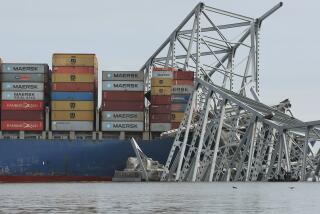Improving State Bridges
- Share via
In response to “Caltrans’ Hard Jolt of Reality,” Part A, Dec. 3:
Your article about Caltrans and bridges prompts a few questions:
Why the love affair with reinforced concrete bridges? Our freeway bridges all appear to have been built from the same set of drawings. They are nearly all multiple box girder reinforced concrete structures. This design is used almost to the exclusion of steel. Just go look at the construction now under way of the Century-405 Freeway interchange.
Reinforced concrete consists of concrete, a basically brittle material of poor strength to weight ratio, and the steel bars with which it is painstakingly reinforced and tied together. With that steel the engineer augments the strength and attempts to improve the ductility of concrete, a relatively weak and brittle material. This begs the question: Why, when the goal is to reduce mass and improve ductility, do we start with concrete, a weak, heavy and brittle material? Why don’t we design steel bridges? I drive under overpasses in states like Tennessee and am impressed. I think they would fare better in an earthquake than our reinforced concrete multiple box girders.
California is the world center for production of composites for airframe construction. These materials offer the possibility of gross improvement in strength to weight ratio and ductility. Should composites not have some consideration?
Why should private sector engineers be almost excluded from freeway bridge design? No matter how excellent Caltrans engineers are, bridge design might be improved by a fresh, unbiased examination of the basic design problem.
HAROLD A. FUTTRUP
West Covina
The writer is a structural engineer.






